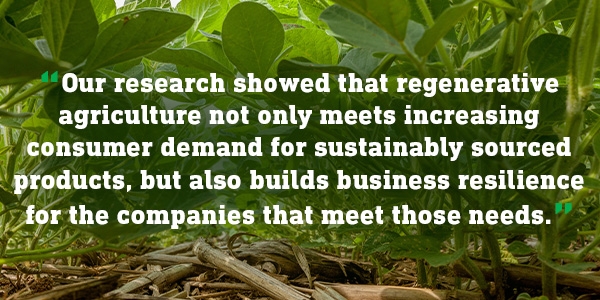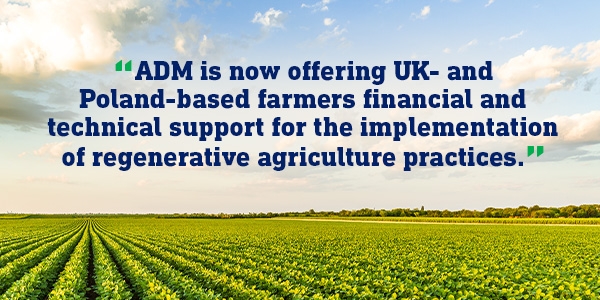Promotional Features
Explaining the urgency behind regenerative agriculture expansion
Sustainability minded consumers are driving efforts to expand regenerative agriculture globally.
ADM’s purpose is to unlock the power of nature to enrich the quality of life, and as a leading global agricultural supply chain manager and nutrition provider, it is uniquely positioned to advance that important work by protecting our planet, our communities and our people.
One way ADM is achieving its purpose is through its leadership role in powering the adoption of regenerative agriculture practices around the globe. ADM defines regenerative agriculture as a system of practices that sequester carbon in the soil and intentionally improve soil health, biodiversity, water quality and air quality while ensuring the viability of farm production.
Based on Indigenous ways of land management and adaptive to local physical conditions and culture, regenerative agriculture revolves around five guiding principles: minimizing soil disturbance; maintaining living roots in soil; continuously covering bare soil; maximizing diversity with an emphasis on crops, soil microbes, and pollinators; and responsibly managing inputs, including nutrients and pesticides.
Consumers understand the value of this work. Industry-wide, revenue from regenerative agriculture is expected to grow from $8.7 billion in 2022 to $32.29 billion by 2032, and ADM is expanding its efforts around the globe as it advances toward its goal of four million regenerative acres by 2025.
Why regenerative agriculture – and why now?
Regenerative agriculture is not just a buzzword – ADM knows this because it asked consumers and consumer product and retail organizations about it. In November 2023, ADM published a comprehensive report, based on survey data from both consumers and consumer product and retail decision-makers obtained via its Outside VoiceSM consumer insights platform. The research showed that regenerative agriculture not only meets increasing consumer demand for sustainably sourced products, but also builds business resilience for the companies that meet those needs.
According to ADM’s survey, 73% of consumers agreed they would be more likely to trust retailers and brands that implement regenerative agriculture programs, while 72% agreed they would be more likely to purchase from those retailers and brands. And on the other side of the store aisle, of the retailers and CPGs who don’t currently have programs in place, 65% said their company plans to adopt a program in the next half decade – or sooner.
In other words, consumers and the companies that serve them understand the importance and urgency of regenerative agriculture, and will continue to power its growth, facilitated by partners across the supply chain – a process that ADM is proud to lead.
Expanding its regenerative agriculture program to Europe
ADM is now offering UK- and Poland-based farmers financial and technical support for the implementation of regenerative agriculture practices, such as conservation tillage, cover crops and companion cropping. In the UK, farmers who grow milling wheat and oilseed rapeseed and enroll in the program will receive incentive payments for each hectare farmed using regenerative practices.
ADM has also partnered with Ceres Rural, a UK-based regenerative agriculture advisory company, to offer one-to-one support for growers throughout the growing season. ADM and partners like Map of Agriculture Ltd., will utilize remote data collection and satellite technology to provide crucial insights into carbon footprints and sustainability performance of the crops of participating growers.
In Poland, producers across ADM’s supply chain can enroll their rapeseed and wheat crops and receive incentives per hectare for implementing regenerative agriculture practices. Like in the UK, these growers will receive guidance starting with on-field assessments, including field visits, and individualized development plans tailored to each specific farm.
Here, soil sampling – which can measure key indicators of success, such as soil health and crop yields – will provide data that ADM reports back to growers to help inform their decision-making processes.
What’s next in Latin America
A similar expansion is underway in Latin America. ADM launched its regenerative agriculture program in Brazil in 2023, engaging 20 soy farmers encompassing 20,000 hectares in Minas Gerais and Mato Grosso do Sul. That program will serve as the launchpad for its work to reach 300,000 regenerative acres in Brazil by 2027.
The initial focus of the pilot will be on three practices: fertilizer use efficiency and increased use of biological inputs; no-till farming; and covered soil and cover crops. Through the pilot, ADM will gather info on current practices and their impacts, including calculating carbon footprints, while providing farmers with technical assistance, training sessions and soil organic matter and carbon sequestration measurements.
Greenhouse gas emissions will be calculated with a tool designed and developed by Bayer S.A. in partnership with Embrapa – quantifying field emissions, land-use change emissions, carbon footprint of inputs applied in the field, and carbon footprint of transportation, and providing ADM, Bayer, and other participants with valuable insights as the program expands.
This is part of ADM’s purpose
Regenerative agriculture can enhance soil health, support biodiversity, lower carbon emissions and provide better outcomes for growers – and there’s a growing appetite from consumers for products that are sourced sustainably. That’s why ADM is working around the globe to scale its regenerative agriculture program, enrolling new acres and providing growers with the financial and technical support necessary for success.
ADM is proud to be a global leader in this important effort and intends to continue increasing awareness of the benefits of regenerative agriculture, so that partners up and down the value chain understand its holistic benefits and can join ADM in advocating for and implementing these sustainable practices.
Bibliography
New Report Demonstrates Regenerative Agriculture's Value for CPGs and Retailers.









